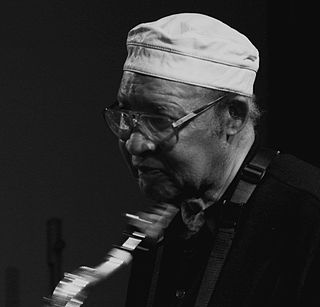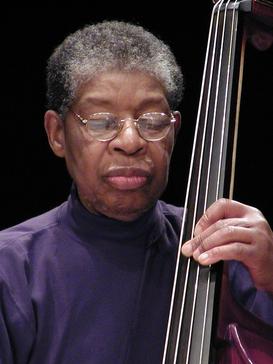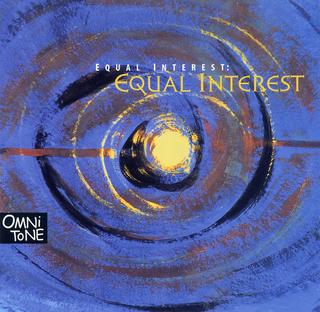
Muhal Richard Abrams was an American educator, administrator, composer, arranger, clarinetist, cellist, and jazz pianist in the free jazz medium. He recorded and toured the United States, Canada and Europe with his orchestra, sextet, quartet, duo and as a solo pianist. His musical affiliations constitute a "who's who" of the jazz world, including Max Roach, Dexter Gordon, Eddie "Lockjaw" Davis, Art Farmer, Sonny Stitt, Anthony Braxton, and The Art Ensemble of Chicago.
The Association for the Advancement of Creative Musicians (AACM) is a nonprofit organization, founded in 1965 in Chicago by pianist Muhal Richard Abrams, pianist Jodie Christian, drummer Steve McCall, and composer Phil Cohran. The AACM is devoted "to nurturing, performing, and recording serious, original music," according to its charter. It supports and encourages jazz performers, composers and educators. Although founded in the jazz tradition, the group's outreach and influence has, according to Larry Blumenfeld, "touched nearly all corners of modern music."

Roscoe Mitchell is an American composer, jazz instrumentalist, and educator, known for being "a technically superb – if idiosyncratic – saxophonist". The Penguin Guide to Jazz described him as "one of the key figures" in avant-garde jazz; All About Jazz stated in 2004 that he had been "at the forefront of modern music" for more than 35 years. Critic Jon Pareles in The New York Times has mentioned that Mitchell "qualifies as an iconoclast". In addition to his own work as a bandleader, Mitchell is known for cofounding the Art Ensemble of Chicago and the Association for the Advancement of Creative Musicians (AACM).

George Emanuel Lewis is an American composer, performer, and scholar of experimental music. He has been a member of the Association for the Advancement of Creative Musicians (AACM) since 1971, when he joined the organization at the age of 19. He is renowned for his work as an improvising trombonist and considered a pioneer of computer music, which he began pursuing in the late 1970s; in the 1980s he created Voyager, an improvising software he has used in interactive performances. Lewis's many honors include a MacArthur Fellowship and a Guggenheim Fellowship, and his book A Power Stronger Than Itself: The AACM and American Experimental Music received the American Book Award. Lewis is the Edwin H. Case Professor of American Music, Composition & Historical Musicology at Columbia University.

Leroy Jenkins was an American composer and violinist/violist.

Pi Recordings is a jazz record label founded by Seth Rosner in 2001. He was soon joined as partner by Yulun Wang. Pi specializes in avant-garde jazz. Its first two albums were by Henry Threadgill.

Fred Anderson was an American jazz tenor saxophonist who was based in Chicago, Illinois. Anderson's playing was rooted in the swing music and hard bop idioms, but he also incorporated innovations from free jazz. Anderson was also noted for having mentored numerous young musicians. Critic Ben Ratliff called him "a father figure of experimental jazz in Chicago". Writer John Corbett referred to him as "scene caretaker, underground booster, indefatigable cultural worker, quiet force for good." In 2001, author John Litweiler called Anderson "the finest tenor saxophonist in free jazz/underground jazz/outside jazz today."
Fred Hopkins was an American double bassist who played a major role in the development of the avant-garde jazz movement. He was best known for his association with the trio Air with Henry Threadgill and Steve McCall, and for his numerous performances and extensive recordings with major jazz musicians such as Muhal Richard Abrams, Arthur Blythe, Oliver Lake, and David Murray. He was a member of the AACM, and a frequent participant in the loft jazz scene of the 1970s. He also co-led a number of albums with the composer and cellist Diedre Murray. Gary Giddins wrote that Hopkins' playing "fused audacious power with mercuric reflexes." Howard Reich, writing in the Chicago Tribune, stated that "many connoisseurs considered [Hopkins] the most accomplished jazz bassist of his generation" and praised him for "the extraordinarily fluid technique, sumptuous tone and innovative methods he brought to his instrument."
Douglas R. Ewart is a Jamaican multi-instrumentalist and instrument builder. He plays sopranino and alto saxophones, clarinets, bassoon, flute, bamboo flutes, and didgeridoo; as well as Rastafarian hand drums.

Malachi Favors was an American jazz bassist who played with the Art Ensemble of Chicago.
Loft jazz was a cultural phenomenon that occurred in New York City during the mid-1970s. Gary Giddins described it as follows: "[A] new coterie of avant-garde musicians took much of the jazz world by surprise... [T]hey interpreted the idea of freedom as the capacity to choose between all the realms of jazz, mixing and matching them not only with each other, but with old and new pop, R&B and rock, classical music and world music... [S]eemingly overnight new venues - in many instances, apartments or lofts - opened shop to present their wares." According to Michael Heller, "lofts were not an organization, nor a movement, nor an ideology, nor a genre, nor a neighborhood, nor a lineage of individuals. They were, instead, a meeting point, a locus for interaction." Heller stated that "loft practices came to be defined by a number of key characteristics, including (1) low admission charges or suggested donations, (2) casual atmospheres that blurred the distinction between performer and audience, (3) ownership / administration by musicians, and (4) mixed-use spaces that combined both private living areas and public presentation space." Regarding the music played in these venues, Michael J. Agovino wrote: "This was community music. Part of the point was that, free of the strictures of clubs, the music could be anything, go anywhere, go on for as long as it wanted." David Such stated that "the cutting contests, personality cults, and vices that characterized the jazz scene of the 1940s and 1950s were mostly missing." The scene was reviewed and documented by Giddins, Peter Occhiogrosso of the SoHo Weekly News, Leroi Jones, Robert Palmer, and Stanley Crouch.
Steve McCall was an American jazz drummer.
Alvin Leroy Fielder Jr was an American jazz drummer. He was a charter member of the Association for the Advancement of Creative Musicians (AACM), Black Arts Music Society, Improvisational Arts band, and was a founding faculty member of the Louis "Satchmo" Armstrong Summer Jazz Camp.

Streaming is an album by Muhal Richard Abrams, George Lewis, and Roscoe Mitchell recorded in 2005 and released on the Pi Recordings label in 2006.

As If It Were the Seasons is the second album by American jazz saxophonist Joseph Jarman, recorded in 1968 and released on the Delmark label.

Roscoe Mitchell Quartet is an album by American jazz saxophonist Roscoe Mitchell recorded in 1975 and released on the Canadian Sackville label.

Tomeka Reid is an American composer, improviser, cellist, curator, and teacher.

Celebrating Fred Anderson is an album by American jazz saxophonist Roscoe Mitchell, which was recorded live in 2015 at Chicago's Constellation and released on Nessa. For this tribute to saxophonist Fred Anderson, Mitchell assembled a quartet with cellist Tomeka Reid, bassist Junius Paul and drummer Vincent Davis and prepared four original pieces and adaptations of two Fred Anderson compositions, "Bernice" and "Ladies in Love".

Equal Interest is an album by Equal Interest, a collaborative project by saxophonist Joseph Jarman, pianist Myra Melford and violinist Leroy Jenkins, which was recorded in 1999 and released on the OmniTone label.

Frequency is the debut album by Chicago-based collective jazz quartet Frequency, featuring saxophonist Edward Wilkerson, flutist Nicole Mitchell, bassist Harrison Bankhead, and percussionist Avreeayl Ra. It was recorded at Riverside Studio in Chicago, and was released in 2006 by Thrill Jockey. The album includes compositions by all four musicians, along with group improvisations.














